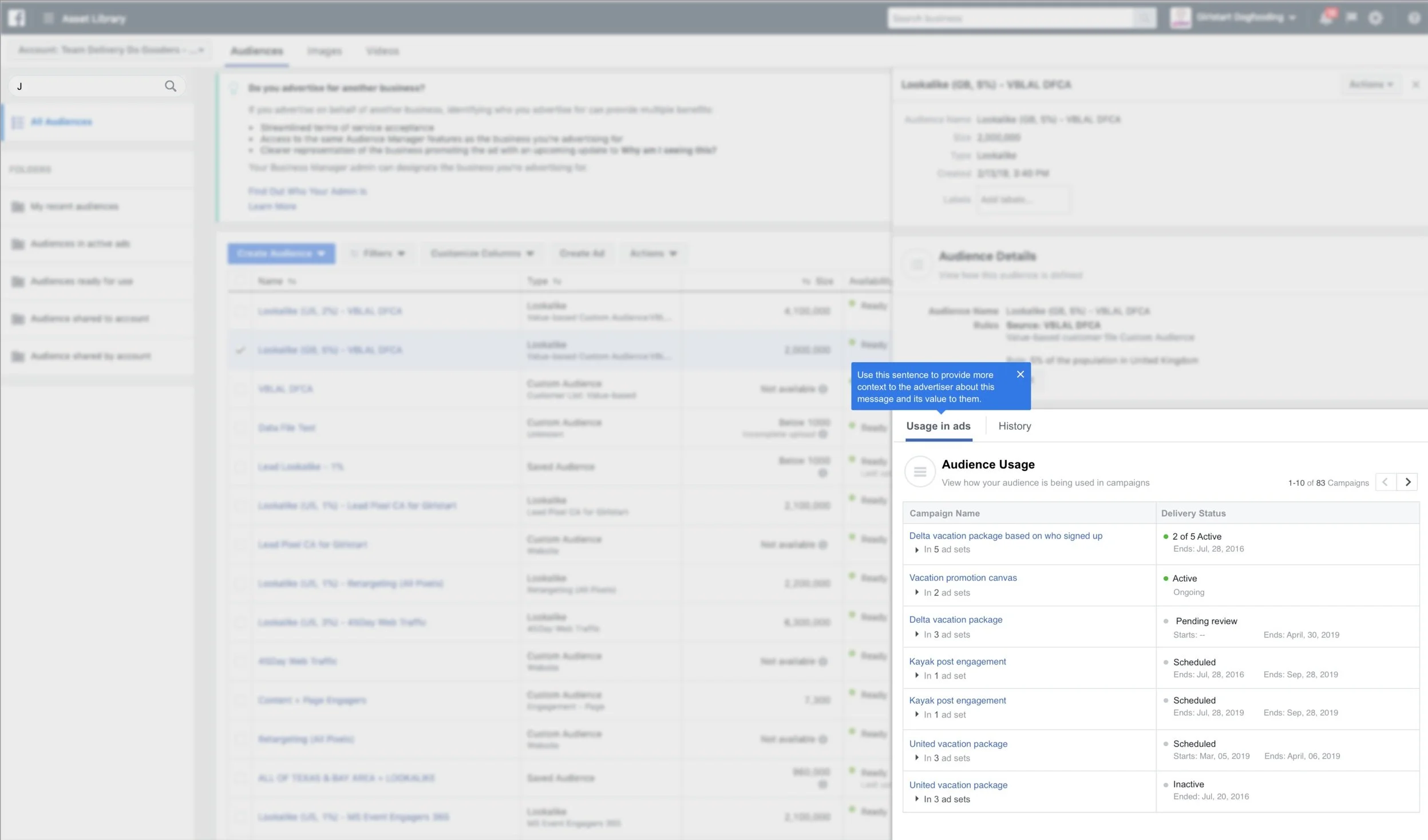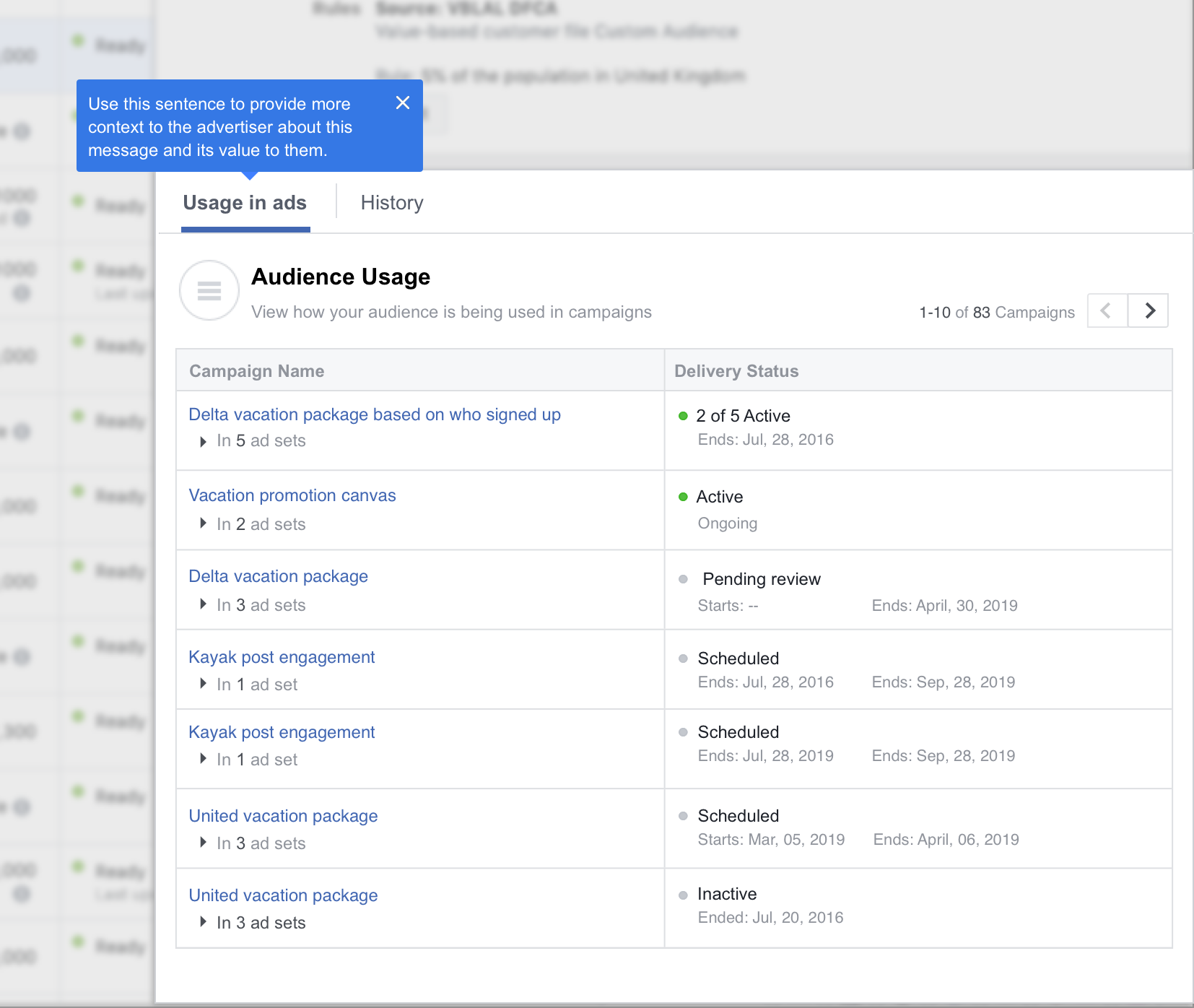Facebook | Advertiser Audience Management
Designed with Project Management, UX Research and Engineering Functional PartnersKey takeaways
Exploration of yadda yadda
Project Breakdown
Project Type: Experience Design
Contributions + Role: Research Synthesis, Workstream Prioritization, Solution Discovery, Concept and Design Development
Summary of impact
Enabled advertisers with the clarity they needed to understand the usage and conditions of their audiences between campaigns, their marketing employees, and strategic partners
Outlined longer-term vision for the management and search-ability of audiences, their use, and performance against associated objects; such as performance objectives, campaigns, and ad creatives
Context
Audience Manager is a repository of huge value as our largest advertisers and users of Custom Audiences and Lookalikes have thousands, sometimes tens of thousands, of audiences. However, the product does not offer a scalable method of organizing, understanding use, or management. There are audiences which are at any given moment powering millions of dollar in revenue.
Currently inefficiencies that are inherent in Audience Manager mean that clients are wasting time and resources on repetitive tasks like recreating and finding the audiences they want to use. This represents both a productivity loss, but also a massive opportunity cost as these are people whose time would be better spent working out how to increase the performance of their campaigns through more effective targeting.
Problems
It’s hard to find the right audiences at the right time
Advertisers couldn’t find what they need due to limited filtering options
Due to lack of discoverability advertisers adjusted by using robotistic naming convention system in order to use our tool which results in operational overhead and confusing asset naming
It’s hard to understand how audiences are being leveraged
Our advertisers don’t visibility or access to the history of where the audience has been used, ultimately obfuscating which campaigns/ad accounts they need to gain performance insights from, or understand cross-team/partner usage
Advertisers aren’t knowledgable about how they can leverage search filters
Research indicated that advertisers found available filtering options valuable when prompted on how they might use filtering. However, looking at usage Data, very view advertisers were actively using filtering options
Facebook Audience Manager Circa 2019. Old version pre-design update. Filter, search and object relationships were confusing, and didn’t meet advertiser needs.
Goals
Give advertisers a scalable way to manager their audiences better and have insights into how they are and have been used.
Improve management of audiences
Increase comprehension for advertisers in how their audiences are being used
In how many Adsets
In what campaigns
Measuring success
In our logging strategy directional signals we looked for to gauge success included:
Less back and forth between Audience and Adset pages in Ads Manager
Quantitative and qualitative data showed that advertisers sessions included a high level of back and forth context switching between pages. Our solution aimed at reducing this behavior.
Overall reduction in the number of total audiences within an Ad Account
With better visibility into how audiences are used help, we wanted to see advertisers “clean” up their accounts with irrelevant audiences as maintaining them was expensive for our system
Process + Execution
Explorations for Understanding Usage
Establish 1 to 1 connection of how audiences are mapped to campaigns
1 to 1 connection of how many adsets those audiences are being used in
Clear visibility to start, end, and scheduled dates for campaigns using said audiences
Detailed view of Audience Usage Panel feature
Explorations for Discoverability
The removal of filter types that are no longer supported
Introduction of Events filter type
All standard events
“Custom event” catchall category
There are currently 3 versions of Audience Manager and 4 URLs
End of half there will be 1
Adopting FDS and moving towards Geodesic standards for filter UI
Longer-term thinking for Discoverability
Search and Discoverability Early Exploration A
Search and Discoverability Early Exploration B
Results + Imact
Reduction in audience duplication due the the fact advertisers understood the usage of their current audiences, and didn’t feel the need to reset or start anew by duplicating an audience to use in a new campaign
Increased usage and adoption of search feature attributed to more prominent placement and clearly defined filters communicating use cases more concretely




